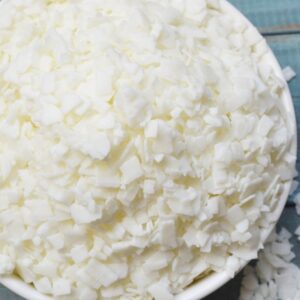At Mill Cottage, the home of Craftsteading, we strive to provide products and services that are ethical, organic, cruelty-free and sustainable. This is why we offer SOY WAX and COCONUT WAX as bases for candle-making. They’re available at our online store.
How to Make Scented Coconut-Soy Candles

Note: Items in CAPITAL LETTERS, are available in the Craftsteading Online Store.
Imagine your home in the evening, softly lit with the gentle, flickering light of candles you’ve made yourself. Imagine the air delicately scented with your choice of fragrant oils.
You can make your own perfumed candles with SOY WAX and COCONUT WAX for your home, or as housewarming gifts for friends. Leave them plain, or add a few drops of ESSENTIAL OILS to blend a perfume of your own design.
The Craftsteading Store stocks CANDLE WICKS, FOOD COLORINGS FOR CANDLE DYES, and other candle-making supplies.
Candle containers
It’s best, if you can, to make your candles in recycled glass jars, washed clean, with lids. Many people keep empty jam, marmalade or jelly jars instead of throwing them out. If you don’t hoard them yourself, perhaps you have family, friends or neighbors who do, and who are glad to give them away to be re-used. Or re-use any small ceramic bowls or cups you might have.
About candle-molds
Some people like to use silicon candle-molds to make free-standing candles in various shapes. We don’t sell these because we try to avoid plastics whenever possible. You can make your own candle-molds by recycling materials found at home. Any paper carton can be re-purposed into a candle-mold, or use discarded metal cans, or re-useable glass containers.
If you cannot get hold of any clean, used jars with lids, we stock pretty, aluminum or glass CANDLE CONTAINERS at the Craftsteading Store.
Our choice of materials
Glass containers are considered more environmentally friendly than aluminum cans or jars, due to their lower greenhouse gas emissions during their lifecycle. However, glass is heavier than aluminum and thus it costs more to ship. So the impact of new glass or new aluminum containers on the environment could be considered approximately equal.
“If you can find aluminum cans made from 100% recycled materials, they should be your top choice when shopping for single-serving beverages,” according to an Earth911 article. “Their low transportation footprint and ease of recyclability make them a winner.”
But perhaps the best solution overall, if you are conscious of environmental sustainability, is to ditch the single-serve packaging altogether. Filling a reusable glass container generates zero waste.
EQUIPMENT YOU’LL NEED
- COCONUT WAX – 1 part (You can experiment with adding up to 2 parts, because coconut wax increases the shelf life of soy wax candles, as well as softening the wax to make it stickier, which is useful in cool climates.)
- SOY WAX FLAKES – 10 parts
- CANDLE WICKS
- CENTERING WICK HOLDERS
- CANDLE WICK STICKERS
- CANDLE CONTAINERS (glass or aluminum)
- CANDLE-WAX MELTING POT (for mixing and melting wax)
- LONG-HANDLED MIXING SPOON
- KITCHEN MEASURING CUP
- KITCHEN THERMOMETER
- FOOD COLORINGS (we consider they’re safer than other candle dyes)
- CANDLE SAFETY STICKERS
- ESSENTIAL OILS (60-80 ml candle fragrance per kilogram, or 2 to 3 oz per 2.2 pounds).
Step 1: Glue Wicks into Jars
Secure WICKS to the bottom center of your clean GLASS JARS (or other candle containers) with a CANDLE WICK STICKER or a dob of hot glue.
If your wicks are long, wrap the excess around a skewer or pencil laid across the top of the jar, to keep them taut while pouring the wax. Or use a CENTERING WICK HOLDER.
Step 2: Measure Soy Wax and Coconut Oil
Using a MEASURING SPOON, measure a ratio of 10 parts soy wax flakes and 1 part coconut wax into a CANDLE-WAX MELTING POT or double boiler, or heatproof glass jar siting in a pot of water on low heat. Four cups of melted wax should yield approximately two small candles.
Step 3: Melt and Mix Wax
With your LONG-HANDLED MIXING SPOON, stir mixture continuously over medium heat until wax flakes are completely liquefied. Use your KITCHEN THERMOMETER to make sure the mixture does not get hotter than about 175 F ( 80 C)
Step 4: Allow to cool slightly
Remove melted wax from heat and let the mixture stand until your KITCHEN THERMOMETER tells you it’s reached about 145 F (63 C). If you choose to add scent or color, now is the time to stir in a few drops of ESSENTIAL OILS (60-80 ml candle fragrance per kilogram, or 2 to 3 oz per 2.2 pounds) and/or candle dye FOOD COLORINGS. You can use as many drops as you like to get your desired strength of perfume and color. The cooler temperature will help protect the essential oils.
Step 5: Pour Wax
Carefully and slowly pour the liquid wax into your recycled glass jars or CANDLE CONTAINERS, leaving 12 mm (1/2-inch) of space at the top of the jar.
Step 6: Allow to stand overnight
Let your candles cool overnight before trimming the wicks down to about half a centimeter (roughly 1/4 inch). Your candles are now ready to use. If you need to store them, be sure to cover them with a lid and keep them in a cool place.


